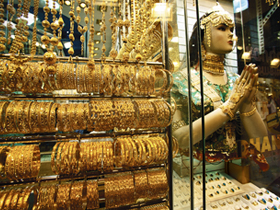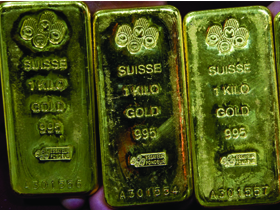
Enough and No More
Indians have had a long love affair with gold; right now they need to spend a little time apart
Since the beginning of time, man has craved it. The Egyptian hieroglyphics eulogised it. The elders of Biblical New Jerusalem paved their streets with it. Mahmud of Ghazni plundered dozens of South Asian sultanates for it. The Red Indians and Spanish conquistadores killed each other along the American Prairie in its cause. And at Zaveri Bazaar, Mumbai, hundreds of middle-class Indians are now queuing up to sell it.
The yellow metal has been riding the crest of a commodity bull wave for the past six years, touching a price of $1,100 per ounce — a mere 28.4 grams — in the international market. Indians initially took part in the euphoria, buying lots of it. For centuries, families have owned gold in the form of jewelry, but it was during this golden run that the metal became an investor’s delight. It was important for the world market because India is the largest repository of gold: One-tenth of the world’s gold is in this country. When India buys, the global gold trade smiles.
But what is this instinct that is now pushing such incorrigible gold-lovers as Indians to convert their holdings into cash? For answers, one must travel back to the most extraordinary price surge in the history of gold, in 1980. The safe haven appeal of gold had shot through the roof on the back of political uncertainties. The Soviet Union had moved into Afghanistan, Iran and Iraq were at war and the US was in recession. Every analyst worth his gold tooth speculated the price would rise further. But Indians were selling gold.
Sure enough, gold prices suddenly started falling like there was no bottom. Afghanistan was still occupied, the Persian Gulf War was still on and economic woes continued. But gold ignored everything and fell. For two decades, it kept bouncing at one-third its peak price. It appears that the metal’s link to inflation fears is not a perennial one and the average Indian can tell when the peak has been scaled.
Thus, the lengthening queue at Zaveri Bazaar suggests that gold will catch its breath and go to sleep for some time.
Ask the Smugglers
Export of gold is not legal in India, but as much as 60 tonnes of it left the country in 2008. In the local markets, homemakers brought their jewels to be stripped and melted. Speculative frenzy took over in the exchanges where paper trading was allowed. To top it all, the beginning of 2009 saw the import of gold coming to a standstill. The message was loud and clear: Indians have gone short on the precious metal. One explanation, however, is that families needed money to tide over difficult times. Many Indians lost their jobs.
As the need for cash became urgent, it seemed sensible to sell gold, especially since gold prices had peaked. For some, rising interest rates on fixed deposits were also an attraction. But the most powerful reason for why the demand for gold is drying up in India is the growing conviction that prices are about as high as they can be. Even the approaching marriage season and festivals have failed to infuse enthusiasm among buyers. This is evident from the volatile price movements in recent weeks, when any price increase has come only from a weakening rupee and not due to fresh demand.
Safe Bet No More?
There is a debate whether the world is seeing the beginning of a recovery from the worst downturn in living history. A strengthening economy, even on a very low base, is a bearish signal for gold. Capital will now get sucked out for investment and consumption.
India is surely doing better than others. The country remains one of the fastest growing economies of the world and its financial system seems to be stabilising. This means that the rupee could revert to its strengthening trend of recent years. Hence, the rupee price of imported gold could fall.
Commodities affected by the same factors track one another in price. Gold has tracked oil in the past and silver has tracked gold. A look at these two commodities must reveal something about gold. First, oil has seen a momentous fall from its peak, before recovering. The fall in gold has not matched the fall in oil. Does it mean that gold has “de-coupled” from oil and is not likely to follow any upward movement in crude prices?
On the other hand, silver seems to be decidedly bearish. If silver traders had hoped that gold would rise, they would have bid up the white metal.
An India Infoline report captures the dilemma crisply: “Gold price movement is inherently “irrational”, as it is not underpinned by any economic returns and reflects nothing tangible... Economically, gold is a non-investment. Nor is it a commodity whose price is determined by commercial supply and demand.”
While the buying has reduced, the supply of gold is only increasing. Scrap sales, from families and pawnbrokers, are going up. In areas where formal banking is hard to find, gold offers a great store of value. When there is extra money, people hoard it in gold. When they need the cash, they go to the nearest money lender who takes that gold as security. “In some ways they see it as even better than a bank. Which bank will open for you in the middle of [the] night?” asks Daman Prakash, a gold importer. It is in the case of default that the pledged gold comes to the market. With gold prices so high, pawnbrokers have made a killing.
In southern India, the opportunity has been tapped by the organised sector too. Two Kerala-based firms, Manappuram Finance and Muthoot Finance, have large gold-loan portfolios. Over 30 lakh people have borrowed against gold from Manappuram at one time or the other, says I. Unnikrishnan, the firm’s managing director.
A compelling pointer to the expected flight of capital from the gold market is the stock market rally since early March. Investment classes such as fixed income products and gold are a counterweight to equities. When one side gets money, the other side loses.
Atul Shah, who heads Emkay Commotrade, believes recent company results and economic data suggest that a safe haven bet is no longer required, assuming that there won’t be any more bank failures. “In these circumstances, I would rather go short on gold, rather than go long,” he said.
It is not that those who expect gold prices to go up have run out of reasons. The economic recovery may prove ephemeral. China is buying more gold. Higher fuel prices and the cash pumped in by the stimulus packages of national governments could spark inflation and thus increase the safe haven appeal of gold.
But the joker in the pack, as in most other things, is the US dollar. The manner in which the dollar has been falling against all currencies could actually make gold a very good investment in dollar terms, but a lousy investment vehicle for currencies which are appreciating against the dollar. This could mean that while gold may continue to be bearish in rupee terms, it could well become a bullish investment in dollar terms.
Thus, you could see gold going back to the $1,100 mark in the global market as predicted by some experts, yet remain subdued in India. Both predictions, seemingly contradictory, could turn out
to be right!
Bonding with Gold
• In 1964, in its war against China, India did not have the money to purchase medicines and arms. In sheer desperation, the government came out with a gold bond scheme. It proved to be a smart idea. People expressed their patriotic fervour by depositing their jewels with the government.
• In 1991, India almost went bankrupt. Its foreign exchange reserves had dwindled to just a month’s worth of imports. Again, gold came to the rescue. The country pledged its gold and raised the money. This was indeed the beginning of economic reforms in India.
• Today, the government is burdened with a huge fiscal deficit. It plans to borrow heavily this year. In this context, a gold bond scheme may be a very good idea. The government could pay a small rate of interest (say 3 percent) on the prevailing market prices. It could then offer this gold as collateral to international bankers and thus draw on foreign exchange at extremely competitive rates, also bypassing the lowered country rating in the process.
(This story appears in the 19 June, 2009 issue of Forbes India. To visit our Archives, click here.)
-
 goldcoinsgain
goldcoinsgainThis is very Good article and gave good information....
on Oct 30, 2009 -
 goldcoinsgain
goldcoinsgainThis article is very nice. It provides good information. Manappuram bank providing all loans....Thanks for the great reading, we buy gold bullion in a recession. I will pass this on to our clients to read.
on Oct 29, 2009 -
 Lakshman
LakshmanExcellent article. Very informative and topical.
on Jun 21, 2009 -
 Saurabh
Saurabhgood article
on Jun 15, 2009 -
 D Chopra
D ChopraGold is bound to rise. Even Yogesh Chabria has predicted that gold will double.
on Jun 15, 2009 -
 subramani B
subramani BVery crisp and informative. It might be interesting to study the role of Private sector banks, initially, and by other banks, later, in popularising gold purchase an an investment tool, especially where retail investor is concerned. A second interesting area is also the use of such small denomination gold coins ( 1gm, 2gm 5gm)as gifting option. One should also look at promoting Gold ETFs SIP as a reasonable hedge against inflation ( though your article suggests that the linkage may be weakening)
on Jun 8, 2009
















